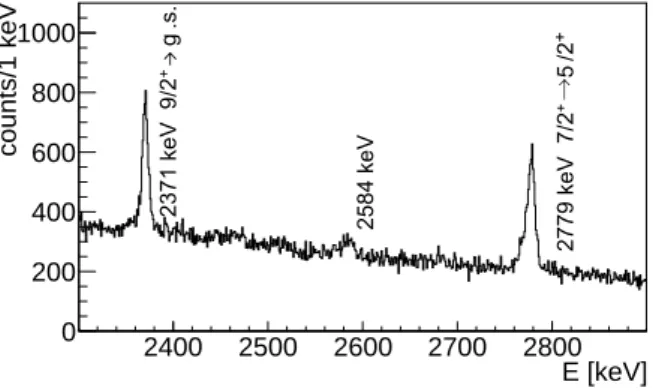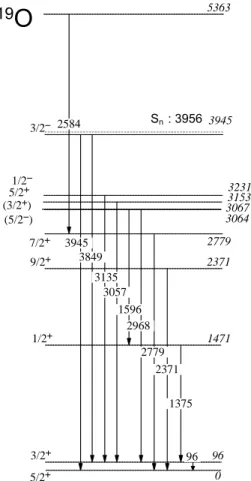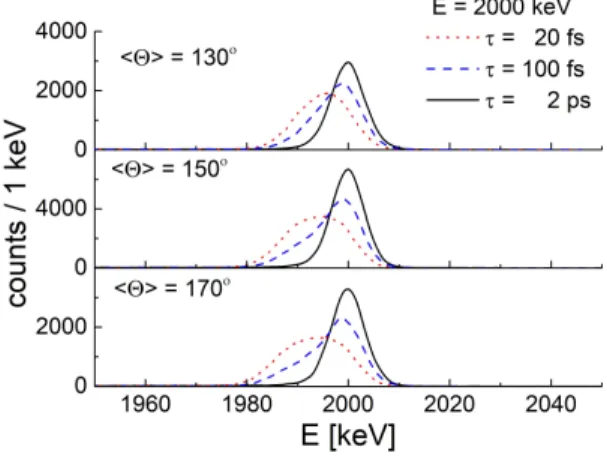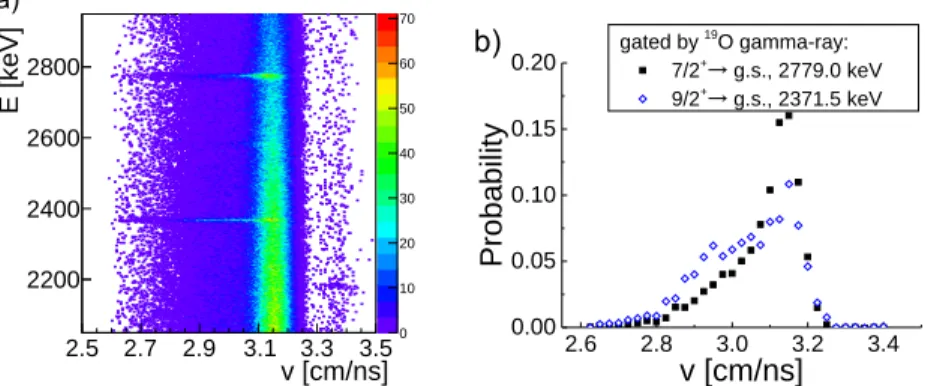HAL Id: hal-02885694
https://hal.archives-ouvertes.fr/hal-02885694
Submitted on 15 Nov 2020HAL is a multi-disciplinary open access archive for the deposit and dissemination of sci-entific research documents, whether they are pub-lished or not. The documents may come from teaching and research institutions in France or abroad, or from public or private research centers.
L’archive ouverte pluridisciplinaire HAL, est destinée au dépôt et à la diffusion de documents scientifiques de niveau recherche, publiés ou non, émanant des établissements d’enseignement et de recherche français ou étrangers, des laboratoires publics ou privés.
Reaction Products: the
19O Test Case
M. Ciemala, S. Ziliani, F. Crespi, S. Leoni, B. Fornal, A. Maj, P. Bednarczyk,
G. Benzoni, A. Bracco, C. Boiano, et al.
To cite this version:
M. Ciemala, S. Ziliani, F. Crespi, S. Leoni, B. Fornal, et al.. Short-range Lifetime Measurements for Deep-inelastic Reaction Products: the19O Test Case. 36th Mazurian Lakes Conference on Physics,
Vol. 51 (2020) Acta Physica Polonica B No 3
SHORT-RANGE LIFETIME MEASUREMENTS FOR DEEP-INELASTIC REACTION PRODUCTS:
THE 19O TEST CASE∗
M. Ciemałaa, S. Zilianib,c, F. Crespib,c, S. Leonib,c, B. Fornala A. Maja, P. Bednarczyka, G. Benzonic, A. Braccob,c, C. Boianoc S. Bottonib,c, S. Brambillab, M. Bastd, M. Beckersd, T. Braunrothd
F. Camerab,c, N. Cieplicka-Oryńczaka, E. Clémente, O. Dorvauxf S. Erturkg, G. de Francee, C. Fransend, A. Goldkuhled, J. Grębosza
M.N. Harakehh, Ł.W. Iskraa, B. Jacquote, A. Karpovi
M. Kicińska-Habiorj, Y. Kime, M. Kmiecika, A. Lemassone, S.M. Lenzik,l M. Lewitowicze, H. Lie, I. Mateam, K. Mazureka, C. Michelagnolin
M. Matejska-Mindao,a, B. Millionc, C. Müller-Gatermannd V. Nanalp, P. Napiorkowskio, D.R. Napoliq, R. Palitp, M. Rejmunde
Ch. Schmittf, M. Stanoiur, I. Stefanm, E. Vardacis, B. Wasilewskaa O. Wielandc, M. Zielińskat, M. Zięblińskia
AGATA, PARIS, VAMOS collaborations a
Institute of Nuclear Physics Polish Academy of Sciences, 31-342 Kraków, Poland
bDipartimento di Fisica, Università degli Studi di Milano, 20133 Milano, Italy c
INFN Sezione di Milano, 20133, Milano, Italy
dIKP Cologne, 50937 Cologne, Germany e
GANIL, CEA/DRF-CNRS/IN2P3
Bd. Henri Becquerel, BP 55027, 14076 Caen, France
f
CNRS/IN2P3, IPHC UMR 7178, 67037 Strasbourg, France
g
Nigde University, Turkey
hKVI — Center for Advanced Radiation Technology, Groningen, The Netherlands i
FLNR, JINR, 141980 Dubna, Russia
jFaculty of Physics, University of Warsaw, Warszawa, Poland k
INFN Sezione di Padova, 35131 Padova, Italy
lDipartimento di Fisica e Astronomia, Università degli Studi di Padova, Padova, Italy m
Institut de Physique Nucléaire (IPN), 91406 Orsay, France
n
Institut Laue-Langevin (ILL), Grenoble, France
o
Heavy Ion Laboratory, University of Warsaw, 02-093 Warszawa, Poland
p
Tata Institute of Fundamental Research, Mumbai 400005, India
q
INFN Laboratori Nazionali di Legnaro, 35020 Legnaro, Italy
r
IFIN-HH, Bucharest, Romania
sUniversità degli Studi di Napoli and INFN Sezione di Napoli, Italy t
IRFU, CEA, Université Paris-Saclay, 91191 Gif-sur-Yvette, France
(Received January 15, 2020)
∗
Presented at the XXXVI Mazurian Lakes Conference on Physics, Piaski, Poland, September 1–7, 2019.
An experiment, aiming at measuring lifetimes of excited states in neu-tron-rich C and O isotopes, was performed at the GANIL laboratory with the use of the AGATA segmented HPGe tracking array, coupled to the PARIS scintillator array and to the VAMOS++ magnetic spectrometer. The nuclei of interest were populated in transfer and deep-inelastic pro-cesses induced by an18O beam at 126 MeV (7.0 MeV/u) on a181Ta
tar-get. This paper contains a brief description of a novel implementation of a Monte-Carlo technique, which allowed us to obtain excited states life-times in the range from tens to hundreds femtoseconds for a reaction with complex initial velocity distribution, making use of the Doppler-shift at-tenuation method (DSAM). As a test case, we present here the analysis for two states in19O: 2371-keV 9/2+ and 2779-keV 7/2+, for which lifetimes
of τ > 400 fs and τ = 140+50−40 fs were obtained, respectively, in agreement with literature values. This newly developed approach will be essential for short lifetimes measurements in neutron-rich systems, exploiting intense ISOL-type beams, currently under development.
DOI:10.5506/APhysPolB.51.699
1. Introduction
The experiment was performed in July 2017 at the GANIL laboratory. The setup included 31 segmented HPGe detectors of the AGATA tracking array [1, 2], the VAMOS++ spectrometer [3] and the PARIS scintillator-based calorimeter [4]. The main aim of the measurement was to determine lifetimes of excited states in neutron-rich C and O isotopes, especially in
16C and 20O produced in low-energy heavy-ion transfer and deep-inelastic
processes. This was motivated by recent advanced ab initio calculations, which predict, for selected electromagnetic transitions, a strong sensitivity to the details of the nucleon–nucleon interaction, in particular to the three-body terms of the nuclear force. The lifetime of the second 2+ state in 20O was measured and compared to the most recent predictions with ab initio methods, while in the case of 16C, an estimate of the lifetime of the state of interest was extracted [5]. Moreover, new spectroscopic information was obtained for17,18,19N isotopes, with preliminary results presented in Ref. [6]. This paper contains a brief description of the results for the19O nucleus, one of the test cases which served to validate our lifetime measurement technique. The proposed method allows access, for the first time, to lifetimes in the tens-to-hundreds femtoseconds range, for reaction products of deep-inelastic processes, i.e. in cases where the initial velocity distribution is complex and not well-defined by the reaction kinematics. As discussed in Section 2.2, a key point of the method is the accurate reconstruction of the complex initial velocity distribution of the reaction product, which cannot be reliably modelled, in particular for the population of specific excited states. This
Short-range Lifetime Measurements for Deep-inelastic Reaction . . . 701
experimental approach will be essential for short lifetimes measurements in exotic regions of the nuclear chart, including r-process nuclei, as soon as intense ISOL-type beams become available.
2. Lifetime determination procedure 2.1. Experimental data
The nuclei of interest were populated in transfer and deep-inelastic pro-cesses induced by a 18O beam at 126 MeV (7.0 MeV/u) on a thick 181Ta target, 6.64 mg/cm2 thick (4 µm), which leads to velocity of projectile-like products of v ∼ 0.1 c. The experimental setup contained 31 AGATA crystals placed at backward angles with respect to the entrance of the VAMOS++ spectrometer (from ∼ 120◦ to ∼ 175◦) and an early implementation of the PARIS array placed at ∼ 90◦. VAMOS++ was placed at 45◦ with respect to the beam direction, covering the angular range of Θ ± 6◦.
The calibration, fine tuning and neutron damage corrections for the AGATA detectors were presented in Refs. [7, 8], while the VAMOS++ ion selection and velocity reconstruction was described in Ref. [9].
The selection of the 19O ions at the VAMOS++ focal plane and the reconstruction of theirs velocity allows the event-by-event Doppler correc-tion of γ-ray energies. Figure1 presents a part of the 19O gated, Doppler
corrected AGATA γ-ray spectrum, in which the 2371-keV 9/2+ → g.s., 2779-keV 7/2+→ 5/2+ and 2584-keV transition are visible. A partial 19O level scheme, including the γ rays observed in the experiment, based on the NNDC [10] and Ref. [11] information, is presented in Fig. 2. It is worth to note that the 2584-keV γ ray is assigned to decay from a neutron-unbound state [11]. Moreover, in the current data, there is a hint for the decay from the 4990-keV neutron-unbound state by a 4894-keV γ ray, quoted in Ref. [11].
E [keV] 2400 2500 2600 2700 2800 counts/1 keV 0 200 400 600 800 1000 2371 keV 9/2 + → g .s. 258 4 keV 2779 keV 7/2 +→ 5 /2 +
Fig. 1. AGATA Doppler-corrected 19O γ-ray energy spectrum. The 2371-keV
9/2+→ g.s., 2779-keV 7/2+→ 5/2+transitions and the 2584-keV transition feed-ing the 7/2+ state are shown.
2584 3945 3849 3135 3057 1596 2968 2779 2371 1375 96 5/2 0 3/2 96 1/2 1471 9/2 2371 7/2 2779 (5/2 ) 3064 (3/2 ) 3067 5/2 3153 1/2 3231 3/2 3945 5363 19
O
Sn : 3956---Fig. 2. 19O partial level scheme including the γ rays observed in the present exper-iment. The placement of the γ rays is based on the data reported in NNDC [10] and Ref. [11].
The evaluated NNDC value for the 2371-keV state lifetime is τ > 3.5 ps [12]. The same Ref. [12] quotes also the 2779-keV state lifetime τ = 117 ± 26 fs. The lifetime of this state is also provided in Ref. [13], which gives a value of τ = 70 ± 26 fs. The evaluated NNDC value is the average of these two values: τ = 92 ± 19 fs.
2.2. Simulations
The nuclear states lifetimes are determined by comparing the measured Doppler-corrected γ-ray energy spectrum line-shapes with simulated ones. As the reaction products velocities were ∼ 3 cm/ns, and the target thickness was 6.64 mg/cm2, we obtain a target-crossing time around few hundreds fs, which constitutes the upper limit of the sensitivity for the technique here employed to extract the lifetimes.
Short-range Lifetime Measurements for Deep-inelastic Reaction . . . 703
Figure 3 presents an example of simulated γ-ray line-shapes for three different lifetime values: 20 fs, 100 fs and 2 ps. For the lifetime around 100 fs, a tail due to not-properly Doppler-corrected events is appearing, while for τ ≤ 80 fs, the presence of a wide shifted peak structure can be observed. In both cases, the effect is dependent on the γ-ray emission angle.
Fig. 3. Results of the realistic simulation of a γ-ray transition with an energy of Eγ = 2000 keV and three different lifetime values τ = 20 fs, 100 fs, 2000 fs,
assuming an emitter ion velocity of 3 cm/ns (v/c = 0.1) and the experimental AGATA angular coverage and response.
The simulation process is divided into stages, starting from the gener-ation of the physics event, which is then passed to the AGATA simulgener-ation and tracking codes. In the event generator, an input for the AGATA sim-ulation is prepared, taking as parameters the excited-level lifetime and the de-excitation γ-ray energy. The crucial part of this stage is the proper as-signment of the ion velocity at the de-excitation point. The reaction mech-anism is quite complex: low-energy transfer and deep-inelastic mechmech-anisms compete in the production of the reaction fragments. Therefore, it is not possible to use a standard Doppler-Shift Attenuation Method, and the ion velocity is reconstructed through an iterative process. The initial velocity reconstruction follows the subsequent steps:
1. The ion velocity after the target (vout) is measured in VAMOS++,
putting a gate on the γ-ray de-exciting the level of interest. Figure4(a) presents the graph of vout vs. Eγ for the 19O ions, while Fig. 4(b)
presents two19O ion velocity distributions corresponding to γ rays de-exciting the 2371-keV and 2779-keV levels of interest for the present test of the method.
v [cm/ns] 2.5 2.7 2.9 3.1 3.3 3.5 E [keV] 2200 2400 2600 2800 0 10 20 30 40 50 60 70 a) 2 . 6 2 . 8 3 . 0 3 . 2 3 . 4 0 . 0 0 0 . 0 5 0 . 1 0 0 . 1 5 0 . 2 0 g a t e d b y 1 9 O g a m m a - r a y : 7 / 2+→ g . s . , 2 7 7 9 . 0 k e V 9 / 2+→ g . s . , 2 3 7 1 . 5 k e V P ro b a b ili ty v [ c m / n s ] b)
Fig. 4. (a) 2D plot of the AGATA Doppler-corrected γ-ray energy vs.19O ion
veloc-ity measured in VAMOS++. (b) Velocveloc-ity distributions for19O ions corresponding to γ rays de-exciting the 2371-keV and 2779-keV levels.
2. A linear probability for the reaction to take place in the target is considered. After the reaction, the kinetic energy of the fragments is calculated assuming the direct population of the excited level of interest (for example, the state at 2371 keV, shown in Fig. 5). The reaction fragment is then let to cross the remaining thickness of the target (in which it slows down) and the VAMOS++ response is applied (see Fig.5). Simulated and experimental velocities are normalized to the highest velocity values and the calculated vout is subtracted from
the measured one, producing the vout used in the next step.
2 . 6 2 . 8 3 . 0 3 . 2 3 . 4 0 . 0 0 0 . 0 5 0 . 1 0 0 . 1 5 0 . 2 0 e x p . d a t a s i m u l . 1 0 0 % E * = 2 . 7 7 9 M e V s i m u l . 7 8 % E * = 2 . 7 7 9 M e V 2 2 % E * > 2 . 7 7 9 M e V P ro b a b ili ty v [ c m / n s ]
Fig. 5. (Colour on-line) Experimentally measured velocity of19O ions,
correspond-ing to γ rays that de-excite the 2779-keV level (black squares), compared to the simulated velocity considering a direct population of the state (dashed blue line) and with additional excitations included (solid red line).
Short-range Lifetime Measurements for Deep-inelastic Reaction . . . 705
3. Up to now, only direct population of the state of interest has been considered. Then, higher excitations of the projectile-like fragment and the target-like partner are considered with steps of 2 MeV. The process is repeated iteratively until the velocity distribution outside the target is fully described by the simulation.
4. In the Monte-Carlo event generator code, a random choice the of ion excitation energy is made, using weights, which are obtained from step 2 and step 3.
The stopping powers used in the code are those proposed by Ziegler et al. [15], which provides very good agreement between measured and calculated maximum vout. The estimated uncertainty of the stopping powers is of the
order of ±2%, as follows from a number of checks performed considering in-flight decays from long-lived states, directly populated in the reaction process. The ion velocity vector angle in the simulation is taken directly from the measured one as a probability distribution into the Monte-Carlo event generator code. With the procedure described above, good agreement between the simulated and the measured ion velocity after passing through the target is achieved (see Fig.5).
In the physics event generator, after the reaction takes place in the target, γ rays are emitted at time which is randomly chosen from the probability distribution defined by the input level lifetime value for the level of the in-terest. The γ-ray Doppler shift is calculated using the ion velocity at the emission point (which for low τ value will be mostly inside the target). The data produced in the event generator are used as input to the AGATA sim-ulation package [14], which has been configured for the 31 AGATA crystals detector geometry. In Fig. 6, a comparison between the experimental and simulated directions covered on the X–Y plane of AGATA is shown. To obtain the agreement, a rotation of the AGATA array by φ = −33.9◦ must be applied in the simulation [2].
−1−1 1 1 Y X a) 1 Y −1−1 1 X b)
Fig. 6. (a) Experimentally obtained view of the dimensionless X–Y plane directions for the positioning of the AGATA crystals compared to simulated ones (b). Values are calculated as: X = xpos/r, Y = ypos/r, where xpos and ypos are x, y covered
The AGATA simulated data are then tracked in the same way as the experimental data using the OFT algorithm [16] and Doppler-corrected using the simulated vout vector (i.e. the velocity after passing the target). In
the simulated data, the experimentally measured energy resolutions for the AGATA crystals are included.
3. Discussion
The simulated γ-ray spectra were compared to the experimentally mea-sured ones for three angular ranges: 120◦–140◦, 140◦–160◦ and 160◦–180◦. The comparison was performed by calculating χ2values (Fig.7(a), (c)) vary-ing the energy of the transition and the state lifetime, used as parameters in the simulation. The minimum of the χ2map obtained for the γ decay of the 2779-keV state in19O was located at τ = 140+50
−40fs and Eγ= 2779.0+1.0−0.8keV.
According to Ref. [11], the 2779-keV level can be fed by γ decay of a state at ∼ 5360 keV, lying above the neutron-separation energy. In Ref. [11], the energy of the γ-ray transition feeding the 2779-keV state was quoted to be Eγ = 2582(3) keV. In the current experiment, a peak at the same energy of
a)
Eγ[keV] τ [f s ]b)
130° 150° 170° Eγ[keV] c) 130° 150° 170° d) 100 fs 500 fs 130° 150° 170° τ [f s ] Eγ[keV] E γ[keV]Fig. 7. (Colour on-line) 2D χ2 minimization map obtained by comparing the ex-perimental γ-ray energy spectra for three angular ranges in the case of the decay from the 2779-keV state (a) and the 2371-keV state (c) in the19O nucleus. The χ2 minimum is marked by a white cross (only for the 2779-keV state), the 1σ region by a white line. Comparison between the experimental γ-ray energy spectra and the simulated ones inside the 1σ region of the χ2map for the decay of the 2779-keV
state (b) and with τ = 100 fs and 500 fs in the case of the decay of the 2371-keV state (d).
Short-range Lifetime Measurements for Deep-inelastic Reaction . . . 707
2584(2) keV was observed in coincidence with19O ions, while no 2165-keV transition populating this state from the 4943-keV level observed in Ref. [11] was seen. The feeding of the 2779-keV level from the state at 5363(3) keV is measured to be equal to 13(2)%. However, as reported in Table 1 of Ref. [11], the width Γγof the 5363-keV state is 0.15 eV, which corresponds to a lifetime of 4.4 fs. Thus, the systematic error due to the feeding should be less than 1 fs. The very short lifetime of the 5363-keV state can be confirmed by the very broad 2584-keV γ-ray line (see Fig.1).
Regarding the 2371 keV state in 19O, no minimum was visible in the χ2 map (see Fig. 7(c)). In contrast, a valley is observed, extending from τ > 400 fs. This is consistent with the literature value of τ > 3.5 ps [10,13], and also the measured transition energy 2370.0+0.5−3 keV agrees well with the known value.
An additional test of the method was performed by considering the 1/2− state in17O, at 3055 keV, depopulated by the 2184-keV γ ray. With the same method, we obtain: E = 2184.3+0.3−0.2 keV, and τ = 159+40−20 fs. This result is consistent with the only existing literature value of τ = 115+87−58 fs reported in NNDC, which is taken from Ref. [17].
4. Conclusions
A brief description was presented of a novel implementation of a Monte-Carlo technique, which allows to obtain lifetimes, in the range from tens to hundreds of femtoseconds, of excited states populated in a deep-inelastic process. As an example, the method was applied to two excited states in19O: the 9/2+ level at 2371 keV and the 7/2+ level at 2779 keV. The measured lifetimes of τ > 400 fs and τ = 140+50−40 fs are, respectively, in agreement with the values quoted in literature. The same method has been applied to measure the lifetimes of the second 2+ states in20O and16C [5]. In the future, using radioactive ion beams for transfer and deep-inelastic reactions, this method can be used to investigate excited level lifetimes in the most exotic neutron-rich regions of the nuclear chart.
This work was supported by the Italian Istituto Nazionale di Fisica Nucleare, by the National Science Centre, Poland (NCN) under contracts No. 2014/14/M/ST2/00738, 2013/08/M/ST2/00257 and 2016/22/M/ST2/ 00269, and by RSF grant No. 19-42-02014. This project has received fund-ing from the European Union’s Horizon 2020 research and innovation pro-gramme under grant agreement No. 654002.
REFERENCES
[1] S. Akkoyun et al.,Nucl. Instrum. Methods Phys. Res. A 668, 26 (2012). [2] E. Clément et al.,Nucl. Instrum. Methods Phys. Res. A 855, 1 (2017). [3] M. Rejmund et al.,Nucl. Instrum. Methods Phys. Res. A 646, 184 (2011). [4] A. Maj et al.,Acta Phys. Pol. B 40, 565 (2009).
[5] M. Ciemała et al.,Phys. Rev. C 101, 021303(R) (2020). [6] S. Ziliani et al., Acta Phys. Pol. B 51, 709 (2020), this issue. [7] S. Ziliani et al.,Acta Phys. Pol. B 50, 625 (2019).
[8] S. Ziliani, Master Thesis, Milano University, 2018. [9] M. Ciemała et al.,Acta Phys. Pol. B 50, 615 (2019).
[10] National Nuclear Data Center,https://www.nndc.bnl.gov/
[11] R. Dungan et al.,Phys. Rev. C 93, 021302(R) (2016). [12] F. Hibou et al., Nucl. Phys. A 171, 603 (1971). [13] C. Broude et al.,Nucl. Phys. A 161, 241 (1971).
[14] M. Labiche et al., AGATA Geant4 Simulations for AGATA@GANIL. [15] J.F. Ziegler et al., The Stopping and Range of Ions in Solids, Pergamon
Press, New York 1985.
[16] A. Lopez-Martens et al.,Nucl. Instrum. Methods Phys. Res. A 533, 454 (2004).




